| SELFWARE 2003 |
|
A Self of Sense
Dr Richard A. BartleSELFWARE.games
20th June, 2003
Introduction
This talk concerns those computer games known as virtual worlds.They come in several flavours:
- Text MUDs (including MOOs and MUSHes)
- LambdaMOO is perhaps the best known
- Graphical MUDs (currently known as MMORPGs)
- EverQuest, Ultima Online, Lineage and 100+ others
The same basic rules apply to all of these, so I'll simply be referring to "virtual worlds".
Warning: this talk contains twice as much material as fits in the time allotted. Strap on your crash helmet, we'll be travelling at speed!
An Assertion
Virtual worlds are about the celebration of identity, hence the relevance to SELFWARE.Academics noticed this in the mid-1990s
- Turkle's group at MIT.
What they didn't realise is that virtual worlds are designed with this in mind.
Neither do most designers...
- They inherit ideas from earlier paradigms
- They don't consider why things are the way they are
Similarly, players pass their cultural values from generation to generation
- Example: acceptability cross-gender play
But...
Doesn't this imply that earlier designers knew what they were doing?It does, and they did:
- Nearly all today's virtual worlds descend from the very first one, MUD
- MUD was explicitly designed to promote identity exploration
- Its culture was deliberately shaped to promote identity exploration
Yeah, right... So tell me how it works
- That's what the rest of this talk concerns
Overview
So, I'm going to provide a theory of identity exploration for virtual worlds.- This is described in detail in my forthcoming book
- I'm not going to tell you its title, though, or you'll think I'm only here to plug it...
I'll be showing that:
- Players find different kinds of thing "fun"
- As they play, their idea of what is "fun" changes along predictable lines
- This is strongly related to the concept of immersion
- As players progress, their "real" and "virtual" selves gradually align, until they find their "true" self
- There's an age-old precedent for this
The Nature of Fun

The traditional player types model:
- Some categories seem to have strong sub-categories
- Suggests that players change type over time, but doesn't suggest how
A Third Dimension
The player types graph has two dimensions- Player/world and active/interactive
My original data suggested a third dimension
- Implicit/explicit
- Implicit is doing something without thinking about it
- Explicit is doing something with forethought
Example:
- Griefers act on players in an implicit fashion
- Politicians ("den mothers") act on them in an explicit fashion
Adding this extra dimension gives us 8 player types instead of 4
New Player Types Graph
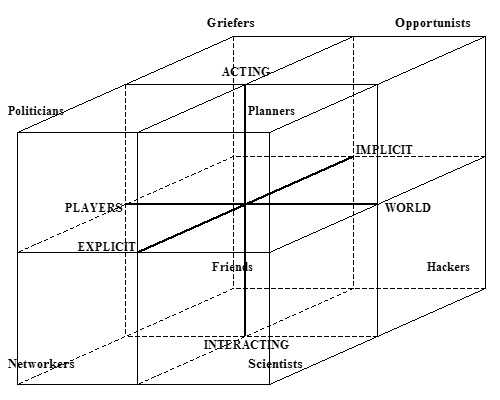
Each sub-cube represents a player type
What this Buys
It explains the difference between griefers and politicians if nothing else...- You can be a "killer" type and not "kill"
Interactions between types can be explained with more fidelity
- But I shan't be doing that today...
The biggest bonus is that it allows the uncovering of player development tracks
- I'll spend the next few slides talking about this
Player Development
From the very early days, it was observed that many players develop in the same way:- They start off trying to kill one another
- Then they move to exploring the virtual world
- Then they try to "win" it
- Then they settle down and socialise
In player type terms:
- Killer=>explorer=>achiever=>socialiser
- On new graph, it's griefer=>scientist=>planner=>friend
There are plenty of exceptions, though.
- Many people start as opportunists
The Main Sequence
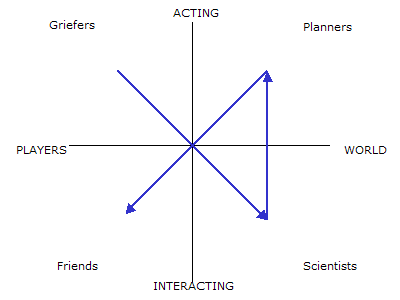
Visible without implicit/explicit dimension
Griefer=>scientist=>planner=>friend
Reverse-alpha shape
The Socialiser Sequence
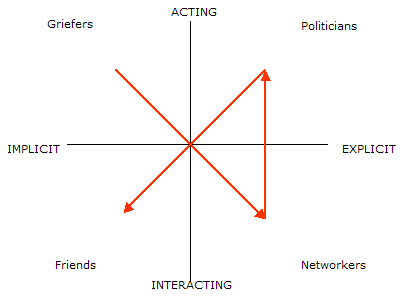
Player half of player/world dimension
Griefer=>networker=>politician=>friend
On old graph, killer=>socialiser=>killer=>socialiser
The Explorer Sequence
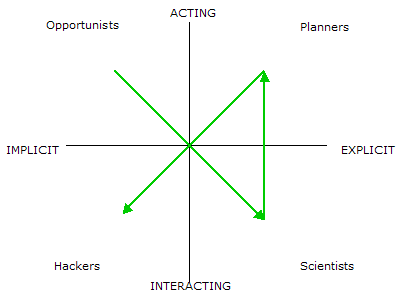
World half of player/world dimension
Opportunist=>scientist=>planner=>hacker
Previously achiever=>explorer=>achiever=>explorer
Minor Sequence
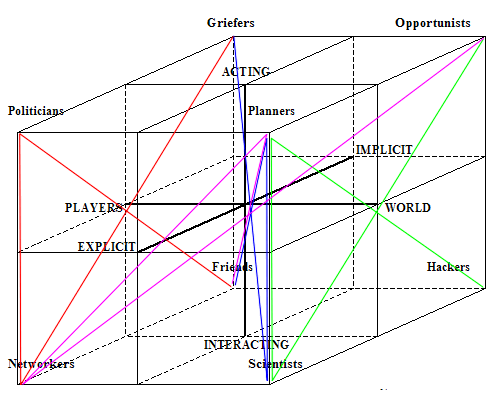
Opportunist=>networker=>planner=>friend
Development Tracks
What we have here are 4 sequences- I obtained these from empirical observation
- There may be others I've missed
In general, players can switch arbitrarily between types as they learn more about themselves

No off-sequence changes to or from politician
- Worrying for symmetry fans.
Designers influence speed of progression
What the Tracks Tell Us
Each sequence starts off implicit, then goes explicit, then returns to implicitIt's a learning exercise
- Find what you can do - your primitive actions
- Seek out meaningful combinations of these actions
- Perform these combinations until they become second nature to you
- Now these sequences are primitive actions for you!
Locate, discover, apply, internalise
It's how babies learn to walk
- But what are the players learning?
- Why do they find this kind of learning "fun"?
What the Tracks Give Players
Development tracks deliver increasing immersion- The sense of being in a virtual world
Levels of immersion:
- Player, (subordinate), avatar, character, persona
Important: it's not a 1-to-1 mapping
- You can be persona-level immersed at planner
- You can reach friend level while unimmersed
This is unsatisfactory for players, though
- Designers should aim to make full immersion (persona) and final development (friend/hacker) coincide
Immersion and Identity
The more immersed you are, the more you become your virtual self and vice versa- Your virtual self is your initial "ideal"
- Challenges cause identity drift in yourself and in your ideal
- Eventually, the two align
This is why people play virtual worlds
The development tracks represent a progression designed to instil a greater sense of immersion
- But most designers don't know that; their designs work merely through the legacy of earlier designs
Q: What do players find fun in virtual worlds?
- A: Whatever it takes to advance them along their preferred development track
Their (almost always unacknowledged) goal is to find themselves
The Hero's Journey
This state of affairs isn't unprecedented...Joseph Campbell's Hero with a Thousand Faces
Has been applied in many narrative situations
- e.g. Star Wars, Harry Potter...
Has also been applied within virtual worlds
- e.g. Shadowbane
The difference here is that it's not a narrative for a character, it's a narrative for you
- You are a real-world person, and the virtual world is the "other world" you visit
- You get to be a hero - if you complete the journey
The match isn't perfect, but let's take a look
Departure
Call to adventure- Advertisement, cover disk, pushy friend...
Refusal of the call
- Lots of reasons not to play
Supernatural aid
- Step can be skipped if you don't need persuading
- But contact with a ranking player or CS rep works
Crossing of first threshold
- Install the client software and power it up
Belly of the whale
- Character creation
- A formal rebirth
Initiation (I)
Road of trials- Small challenges that test extent of your abilities
- (opportunist/griefer)
Meeting with the goddess
- Seek knowledge, through experiment or through others
- (scientist/networker)
Woman as the temptress
- Are you in it for the long haul?
- Transition from seeking to doing
Atonement with the father
- Attempt to "win" the game in terms of its achievement metrics
- (planner/politician)
- The key moment of virtual existence
- Who is the "father"? The lead designer...
Initiation (II)
Apotheosis- Challenges no longer seen as important
- (friend/hacker)
Ultimate boon
- This is where it breaks down.
Most developers don't want their players to leave, so don't give them a boon
- Is that ethical?
In my own games, we do give them a boon
- and did so before I ever heard about Campbell's work..!
Return (I)
Refusal of return- You have power, respect, peace, friends. Why return?
The magic flight
- Live team tries to tempt you to stay
- Add extra content
- Offer you a position of authority
Rescue from without
- "Stop spending so much time on that computer"
- It gives you the excuse you need to stop
Crossing of the return threshold
- You stop because you don't need to play any more
- Not a clear threshold, though
Return (II)
Master of the two worlds- Your virtual and real selves are the same
- For you, the virtual world is a place like any other
- It's lost its mythical significance
Freedom to live
- You can finally be yourself
Conclusion
Playing virtual worlds is a kind of hill-climbing activity through identity spaceThe Hero's Journey is a good algorithm for finding a local maximum, if not a global one
Players follow predictable development tracks as they pursue their personal hero's journey
This is reflected in increasing immersion
When your real-world self and your virtual-world self coalesce, your task is complete
Designers need to understand all this, or they're doing their players a disservice
- And if they do understand it but choose to carry on regardless..?
Copyright ©
23rd June :\webdes~1\ m.htm